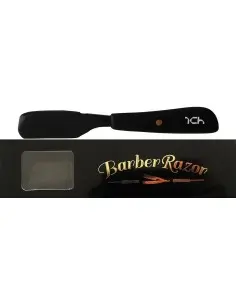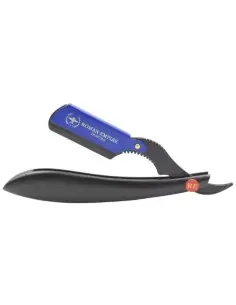- HairMaker.Gr
- Traditional Shaving
- 6 likes
- 4684 views
- 1 comments
- Shavette, professional shavette

The History of the Shavette
The shavette has its origins in the continuous evolution of shaving tools. While the traditional straight razor has been used for centuries, the need for greater hygiene and convenience led to the development of the shavette.
The shavette first appeared in the 20th century, designed to offer barbers a tool that maintained the precision of a straight razor but with the ability to change blades for improved hygiene. This innovation quickly made shavettes popular in barbershops and later became a staple in many men's grooming routines.
- Today, the shavette is a favorite choice for both professionals and traditional shaving enthusiasts, offering an ideal balance of precision, hygiene, and practicality.
- Are you looking for a professional-quality shave without the hassle of sharpening blades? A shavette is the perfect solution for achieving a precise, close shave with minimal maintenance. Unlike traditional straight razors, which require stropping and honing, shavettes use replaceable blades, ensuring a hygienic and effortless shaving experience.
- Whether you're a barber, grooming enthusiast, or beginner in wet shaving, a shavette offers control, precision, and ease of use. In this guide, we’ll explore the benefits of shavettes, how to use them, the best models available, and why they are an excellent choice for those seeking a high-quality shaving routine.
Why Choose a Shavette?
A shavette is a modern alternative to the classic straight razor, designed for those who want a barbershop-quality shave with less effort. Here’s why it stands out:
✅ Closer and Cleaner Shave
A shavette delivers an ultra-close shave, removing hair at skin level with precision. The sharp, disposable blades allow for a smooth and irritation-free shaving experience, making them ideal for sensitive skin.
✅ Replaceable Blades for Hygiene
Unlike straight razors, which require frequent sharpening and cleaning, a shavette uses disposable blades. This ensures a clean, bacteria-free shave every time, making it a preferred choice for professional barbers and home users alike.
✅ Cost-Effective & Low Maintenance
A shavette eliminates the need for strops, honing stones, or expensive blade replacements. With easily interchangeable blades, you save money while maintaining top-tier shaving quality.
✅ Ideal for Beginners and Professionals
New to wet shaving? A shavette provides the control of a straight razor without the learning curve. It’s also a go-to tool for barbers, allowing them to create clean lines and defined beard shapes effortlessly.
How to Use a Shavette: Step-by-Step Guide
Using a shavette may seem intimidating, but with the right technique, it’s easy to master. Follow these steps for a flawless shaving experience:
Step 1: Prepare Your Skin
- Start with warm water to soften the beard and open pores.
- Apply a high-quality shaving cream or soap to create a protective lather.
- Let it sit for 1-2 minutes to further soften the hair.
Step 2: Insert the Blade
- Open the shavette handle and carefully insert a fresh, high-quality razor blade.
- Ensure it is securely placed before closing the handle.
Step 3: Shaving Technique
- Hold the shavette at a 30-degree angle to the skin.
- Use light, controlled strokes—avoid applying too much pressure.
- Shave with the grain (in the direction of hair growth) for a comfortable experience.
- For a closer shave, reapply lather and shave against the grain in the second pass.
Step 4: Post-Shave Care
- Rinse with cold water to close pores and soothe the skin.
- Apply an alcohol-free aftershave or moisturizer to reduce irritation.
- Clean and dry the shavette thoroughly before storing it.
Looking for the best shavette? Here are some top-rated models:
Top Shavettes for Precision Shaving
✔ Stainless Steel Shavettes – Rust-resistant and durable.
✔ Wood & Resin Handle Shavettes – Comfortable grip for easy handling.
✔ Professional Barber Shavettes – Designed for clean, sharp lines.
Must-Have Shaving Accessories
✔ Shaving Brush – Creates a rich lather for smoother shaving.
✔ Pre-Shave Oil – Softens beard hair and protects the skin.
✔ Aftershave Balm – Soothes and hydrates post-shave.
Shavette Maintenance & Care Tips
To extend the life of your shavette, follow these care tips
✅ Replace blades regularly for the best hygiene and performance.
✅ Clean and dry after each use to prevent rust and bacteria buildup.
✅ Store in a dry place and avoid exposure to excessive moisture.
By taking care of your shavette, you ensure a smooth, precise shaving experience every time.
Tips for Shaving with a Shavette Razor
Shaving with a shavette requires precision and technique to achieve a smooth and irritation-free shave. Here are some essential tips to help you master the art of using a shavette razor:
1. Prepare Your Skin Properly
- Wash your face with warm water and a gentle cleanser to remove dirt and oil.
- Apply a pre-shave oil or a hot towel to soften the beard hairs.
- Use a high-quality shaving cream or soap to create a rich lather.
2. Use the Right Blade
- Always use a fresh, sharp blade for the smoothest shave.
- Avoid reusing disposable blades multiple times, as they can become dull and cause irritation.
- Experiment with different brands to find the best blade for your skin type.
3. Hold the Razor Correctly
- Hold the shavette at a 30-degree angle to your skin to avoid cuts.
- Use a light grip to maintain control and prevent excessive pressure.
- Stretch the skin with your free hand for a closer and safer shave.
4. Use Short, Controlled Strokes
- Avoid long strokes; instead, use short, precise strokes to minimize irritation.
- Shave in the direction of hair growth (with the grain) to reduce the risk of razor burns.
- For a closer shave, reapply lather and shave across or against the grain carefully.
5. Maintain the Right Pressure
- Let the weight of the razor do the work—don't apply too much pressure.
- A gentle touch reduces the risk of nicks and irritation.
6. Keep the Blade Clean
- Rinse the blade frequently under warm water to prevent clogging.
- Avoid tapping the razor against the sink, as it can damage the blade.
7. Aftercare is Essential
- Rinse your face with cold water to close the pores.
- Apply an alcohol-free aftershave or moisturizing balm to soothe the skin.
- If you experience any cuts, use an alum block or styptic pencil to stop bleeding.
8. Practice and Patience
- Shaving with a shavette takes time to master—start slow and be patient.
- Focus on technique rather than speed to avoid mistakes.
- With experience, your shaving confidence and results will improve.
Frequently Asked Questions (FAQs)
❓ Is a shavette better than a straight razor?
✔ Yes! A shavette offers the precision of a straight razor with the added benefit of replaceable blades, making it more hygienic and low-maintenance.
❓ Can beginners use a shavette?
✔ Absolutely! A shavette is a great starting point for learning traditional shaving techniques without the commitment of sharpening and stropping.
❓ What blades work best with a shavette?
✔ High-quality double-edge blades (snapped in half) or single-edge blades designed for shavettes.
Key Factors to Consider When Choosing a Shavette & Improving Your Shave
When selecting and using a shavette, multiple factors affect the shaving experience. Understanding the importance of length, weight, material, and blade type can help you achieve a smooth and precise shave.
1. Length of the Shavette
- Shorter shavettes (4-5 inches closed) offer more control, especially for detail work like shaping beards and mustaches.
- Longer shavettes (5.5-6 inches closed) provide better reach and can make shaving larger areas smoother.
- Blade exposure: A longer blade or more exposure means a closer shave but also increases the risk of cuts.
Tip: If you are a beginner, start with a standard-length shavette (~5 inches) for a balance of control and efficiency.
2. Weight of the Shavette
- Lightweight shavettes (40-70g) require a steadier hand and more control from you, as they don't apply much natural pressure on the skin.
- Heavier shavettes (80-120g) allow the weight of the razor to do more of the cutting, reducing the need for extra pressure.
- Balance matters – a well-balanced razor (weight evenly distributed between the handle and blade) improves handling.
Tip: If you're new to shavette shaving, go for a mid-weight shavette (~80g) to have better control without needing excessive pressure.
3. Handle & Grip Material
- Metal handles (stainless steel, aluminum) add weight and durability but can be slippery.
- Resin or plastic handles are lighter but might lack durability.
- Textured grips or finger notches help prevent slipping, especially when shaving with wet hands.
Tip: Choose a handle with texture or grip-enhancing material to ensure a secure hold.
4. Blade Type & Compatibility
- Shavettes use replaceable blades, and compatibility varies by model.
- Half DE blades (double-edge blades snapped in half) – Common in most shavettes, widely available, cost-effective.
- Injector or proprietary blades – Some shavettes (like Feather Artist Club) use longer, sharper blades that last longer.
- Blade exposure matters – More exposed blades give a closer shave but can be harsher on the skin.
Tip: If you have sensitive skin, start with milder DE blades (e.g., Astra Green, Derby) and upgrade as you gain experience.
5. Blade Loading & Locking Mechanism
- Clip-in / snap-lock system: Secure and fast blade changes but may loosen over time.
- Screw-lock / tension system: Offers a tighter grip on the blade, ensuring stability but takes longer to change.
- Magnetic blade holders: Newer designs use magnets for easy blade alignment.
Tip: Choose a sturdy blade-locking system to prevent blade movement during shaving.
6. Shaving Technique Considerations
- Angle: Keep a 30-degree angle to prevent cuts and irritation.
- Pressure: Let the weight of the shavette do the work – don’t press down.
- Stroke length: Use short, controlled strokes, not long, sweeping motions.
- Stretch the skin: Taut skin provides a smoother surface, reducing the chance of nicks.
Final Thoughts
Choosing the right shavette length, weight, handle grip, and blade type can greatly improve your shaving experience. Beginners should opt for a mid-weight, standard-length shavette with a secure grip and mild blades before experimenting with more aggressive setups.
Final Thoughts:
Why a Shavette is a Must-Have ?
A shavette is the perfect grooming tool for those who want a close, professional shaving experience with minimal maintenance. Whether you're a beginner or a seasoned shaver, the benefits of hygiene, precision, and affordability make it a superior choice.
Ready to upgrade your shaving game? Explore the best shavettes and accessories today!
Explore Related Categories:
Get 10% Off Your First Order!
Subscribe to our newsletter and receive grooming tips, new arrivals, and exclusive offers straight to your inbox.
- ✔️ No spam — promise!
- ✔️ You choose only what you want to receive.
- ✔️ 10% discount on your first purchase.
Only benefits. No nonsense.

Giannis – Owner of HairMania Greece & Founder of HairMaker.Gr
Professional hairstylist specializing in men’s & women’s care with 25 years of experience. Owner of HairMania Greece and founder of HairMaker.Gr.
Together with the HairMaker.Gr team, I publish articles based on real in-salon tests, client feedback, and daily hands-on experience.
Questions about hair or grooming? Email us at info@hairmaker.gr.
Follow us:
@hairmakergr | @hairmaniagr
Reviewed and fact-checked by Giannis – Professional hairstylist with 25 years of experience











Comments (1)